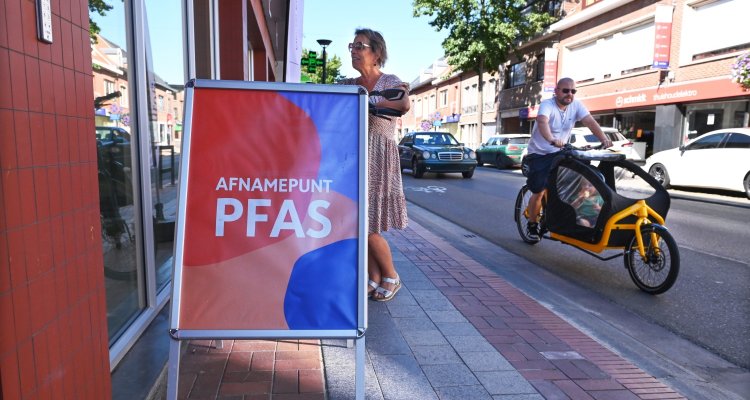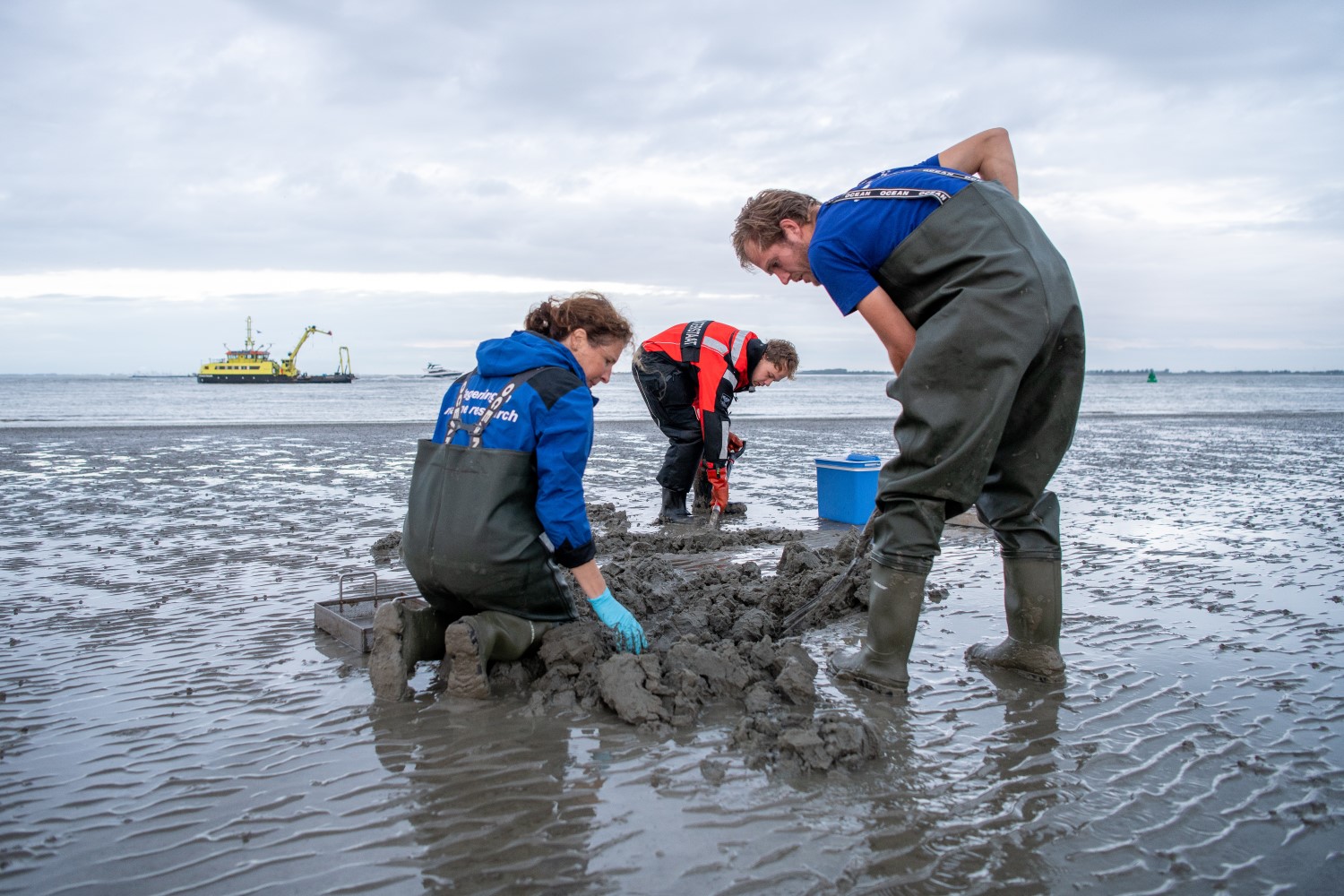
Wageningen World
PFAS: stubborn and hard to replace
Per- and polyfluoroalkyl substances (PFAS), make clothing waterproof and paper grease-resistant, but they are so persistent that you find them in foods and the environment. Researchers are trying to figure out where the substances end up, what their impact is, and above all, how we can get rid of them.
Lead photo: Peter Hilz / ANP
PFAS pollution has only recently become a hot topic, but a lot of researchers have been aware of this group of problem substances for at least 20 years, says Stefan van Leeuwen, senior researcher into contaminants at Wageningen Food Safety Research (WFSR). ‘We are starting to pay attention to them now because it has become clear in the last few years that these substances have a certain toxicity after all. We know now that PFAS in the environment and in our food can affect our health.’ Last year, this led to warnings against eating certain foods, including fish from the Westerschelde and eggs from hobby chickens throughout the Netherlands. Van Leeuwen’s work is all about analysing chemical substances in the environment and in our food. These might be pesticides, flame retardants, PCBs or dioxins.
Wageningen World
Van Leeuwen: ‘They are all persistent substances, which don’t break down easily and therefore stay around for a long time. PFAS are a prime example of persistence in that respect. The combination of carbon and fluorine makes PFAS extremely stable. If you wanted to destroy them, you would have to heat a furnace to 1200 degrees before they would fall apart completely.’
Traces everywhere
The dirt-, grease- and water-resistant qualities of these ‘forever chemicals’ make them handy as a coating on wrapping paper, clothing, shoes, furniture and carpets. PFAS are also used for making non-stick pans, lubricants, pesticides and heat-proof foam for fire extinguishers. Since the 1950s, PFAS have been used all around the world on a large scale, and you can therefore find traces of them everywhere: in household dust, garden soils and surface water. If you measure carefully, you’ll find some PFAS in everyone’s blood: once you’ve ingested them, you don’t urinate most PFAS out again.
In laboratory analyses, a couple of widely used PFAS stand out, particularly PFOS and PFOA. But there are many more kinds of PFAS: over 500 different PFAS have been reported by industry to the European register of chemicals (REACH) alone. But they cannot all be measured in the lab yet, says Van Leeuwen. ‘We know there must be more, because we have demonstrated the presence of a number of them in our research. Varying numbers are mentioned, ranging from hundreds to even thousands of kinds of PFAS. We don’t know exactly how many there are, and nor do we know what concentrations they occur in.’About five years ago, the European Food Safety Authority (EFSA) concluded from its research that exposure to four commonly found PFAS had a negative impact on the human immune system. Van Leeuwen: ‘New limits were established on the basis of that knowledge. If you stay below them, you can be fairly sure nothing will happen. Since the new limits are 10 times lower than the old ones, you get into the danger zone sooner, through food, for instance.’
In 2022, the new limits led to warnings being issued in Dordrecht to people living near Chemours, a company that has been producing PFAs for decades. WFSR analysed fruit and vegetables in the area. The National Institute for Public Health and the Environment RIVM then carried out a risk analysis, and said that residents of Dordrecht, Papendrecht and Sliedrecht should not exclusively eat home-grown vegetables but interchange them with vegetables from the supermarket. This year, the same advice came for the whole country with regard to eggs from hobby chickens: eat them in moderation and interchange them with shop-bought eggs.
Minute amounts
It is not easy to measure PFAS, says Van Leeuwen. ‘We’re talking about minute amounts. In vegetables from Dordrecht we’re talking about picograms of PFAS per gram. You can compare that with one and a half grains of sugar dissolved in an Olympic swimming pool. And there is laboratory equipment that contains PFAS, which can distort your measuring. So you need to be very aware of what equipment you buy for your research.’
Van Leeuwen and his colleagues are developing new laboratory techniques with a view to obtaining a fuller understanding of PFAS pollution in things like food and livestock feeds. One approach involves chemical screening that measures the total organically bound fluorine content. ‘If the fluorine content is much higher than you get in well-known types of PFAS such as PFOS and PFOA, you known that there must be something else as well. That is reason to investigate further using mass spectrometry.’
Shrimps and fish
In the Westerschelde estuary, PFAS are prominently present in shrimps and fish, shows research by Wageningen Marine Research. This pollution comes from waters from the densely populated Flemish hinterland, including from discharge from factories such as 3M near Antwerp. What the PFAS contamination does to nature is still largely unclear, says marine biologist Martine van den Heuvel of Wageningen Marine Research. ‘PFAS are relatively new in ecotoxicology. What is more, these substances behave differently to the classic pollutants such as PCBs. PFAS stick to proteins and cell membranes, whereas PCBs get into body fat. This means we can’t make much use of existing ecotoxicological knowledge. What we do know from research on people and lab animals is that PFAS are not acutely toxic but that they can have subtle effects over the longer term. These can include a sub-optimally functioning immune system, a lower birth weight and disruption of the thyroid hormones. These things are not easy to spot or measure, so long-term studies are needed to find out whether plants and animals are affected by them.’

Concern about PFAS pollution led in 2021 to extensive Wageningen research in the Westerschelde at the behest of the province of Zeeland. Measurements were taken in mussels, oysters, shrimps and several fish species such as bass and flounder. Marine vegetables such as sea lavender were also analysed. For RIVM, the research results were sufficient reason to recommend not eating more than two portions of self-caught flounder or shrimps from the Westerschelde a year, or more than seven portions of mussels and oysters; the PFAS levels are lower in shellfish.
Accumulating in the food web
The analyses show that not all animal species absorb PFAS to the same degree. Their environment and diet and their place in the food web play a role, because some PFAS tend to accumulate. Van den Heuvel: ‘PFAS consist of substances with both short and long carbon chains. The short ones are more water-soluble, and the long ones less so. PFAS with long chains attach themselves more to organic matter in the soil and accumulate more readily in a food web. You can imagine that bottom-feeders like flounder have more contact with the PFAS that can accumulate through the food they get from the riverbed. Seals eat flounders and then never get rid of the PFAS. We are now working on research on different species of organisms, such as worms that live in the soil , to see how these substances are passed on in the food web and what the consequences can be.’
In 2023, the Netherlands, Germany, Denmark, Norway and Sweden submitted a proposal for a ban on PFAS to the European Chemicals Agency (ECHA). Working out the details, including possible exemptions, is going to take at least three years, but it is clear that the end is in sight for the large-scale use of PFAS in Europe.
Replacing PFAS is one of the toughest challenges we face
‘Banning and phasing out cannot be done without replacing them. There’s a reason PFAS are in all kinds of products and processes. You’ve got to look for other chemical substances or new materials that can take over the function of PFAS. Far too little attention is being paid to that problem,’ says Jacco van Haveren, the programme manager for Safe and Circular Biobased Products at Wageningen Food & Biobased Research. He has long been working on how to replace problem substances such as acrylate in paint and plasticizer in plastics.
‘Sometimes PFAS are used as a kind of soap or cleaning product, and that is relatively easy to find substitutes for. But in protective coatings for pipes in industry it’s not so easy, and the same goes for the production of medicines or the manufacture of chips and high-tech electronics. In discussions with industry, we are trying to get a better idea of the massive diversity in the applications.’
Many of the useful properties of PFAS, such as protecting cardboard and paper, come from the fluorine in its ‘tail’. It is not easy to imitate that structure with other chemical building blocks, says Van Haveren. ‘Fluorine compounds are both water-resistant and grease-resistant and they hardly react to anything. You can’t find that combination of properties in many other materials.’
Lanolin as an alternative
In the coming years, his group is going to work with the University of Amsterdam and RIVM on a study of the potential of biodegradable lanolin as an alternative to PFAS for making clothing waterproof. ‘The question is whether you can use it as the basis for then optimizing the properties, or as a model for making other molecules resembling lanolin, with even better properties.’
According to Van Haveren, it is probably unrealistic to expect to find a comprehensive alternative to PFAS. ‘We might have to compromise on quality a bit. After all, replacing PFAS is one of the most difficult challenges we face. If water resistance is the most important property, maybe you can accept a slightly lower level of grease-resistance.’
New PFAS filter
PFAS are very difficult to capture. Drinking water companies use colossal filters
with active carbon. The filters have to be replaced regularly and the carbon is
disposed of as chemical waste, which costs millions of euros per year. An international team led by Fedor Miloserdov and Han Zuilhof of the Laboratory for Organic Chemistry published research results in April that provide hope for an alternative. The researchers succeeded in removing PFAS from water efficiently using special ring-shaped molecules (pillararenes).

The reason the new material works so well is that two mechanisms reinforce each other, says Zuilhof. ‘Pillararenes have five locations with a positive charge and they attract the negatively charged side of PFAS. The fluorine tails of the PFAS
molecules also attract each other, which makes the compound extra strong. After
that, we can concentrate the PFAS in a small volume. You only have to rinse out
the filter material with a bit of alcohol and then you can destroy the PFAS.’ Zuilhof has handed over the patent on this discovery to Wetsus research institute, which wants to continue developing this water purification technique together with WUR and industrial partners.